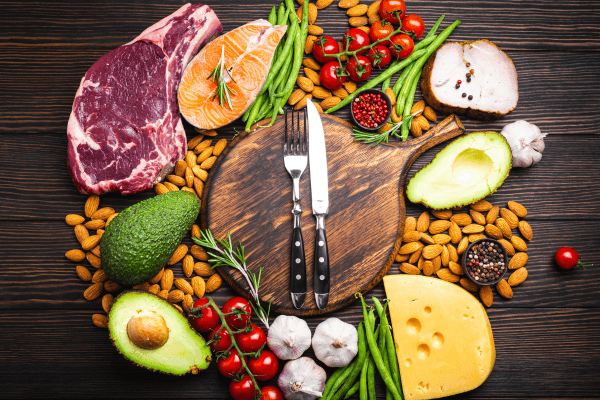Every day, new diets emerge. Knowing the diet’s benefits and drawbacks is very crucial. It is even more crucial to know whether the diet is right for you.
Not every diet is customised to fit every individual.
Diets like Paleo and keto were popular, however they were later adjusted to suit the current trends.
In this blog, we will learn about the keto and Paleo diets, their differences, and benefits of the both.
Keto and paleo: What is it?
It is a diet that mainly emphasises eating foods that were commonly taken in the palaeolithic (stone age). To align with common foods and trends, the modern paleo diet tries to mimic and alter the practice that has been followed for years.
The paleo diet focuses on whole, unprocessed foods, including vegetables, lean meats, fish, nuts, seeds, and fruits. The diet avoids processed foods, refined sugars, and artificial additives, excluding grains and legumes.
Consuming a diet rich in whole grains and lean protein has potential benefits such as weight management, blood sugar control, and improved digestive health. The paleo diet may be challenging to adhere to, while others find it successful.
The ketogenic diet goal is to put the body into a ketosis state (the body burns fat for energy). The diet majorly focuses on high-fat and low-carb. In a ketosis state, the body changes its energy source from glucose to ketone (produced from the breakdown of fats). The diet was mainly followed by people who have epilepsy or any brain disorders.
The keto diet is accompanied by fasting or intermittent fasting, this helps in transitioning the body to a ketosis state and enhances the production of ketones. When following a ketogenic diet, it is important to stay hydrated and maintain electrolyte balance.
The diet avoids having high-carbohydrate foods, starchy vegetables, sugars and sweeteners, legumes, beans and processed foods. The keto diet helps in weight loss, blood sugar control, mental clarity, and epilepsy management.
Similarities of keto and paleo diet
Emphasis on whole foods
The common focus in both diets is the whole foods, nutritional value, avoidance of additives, and alignment of ancestral eating patterns.
The keto diet focuses on lean meats, non-starchy vegetables, and healthy fats. The paleo diet focuses on lean meats, vegetables, fruits, nuts, and seeds.
Both diets eliminate the inclusion of processed foods, high carbohydrates, additives, and limited exposure to harmful substances.
Refined sugars are eliminated and only natural sources like sweetness from berries or low-carb sweeteners are accepted.
Limited carbohydrates
Both diets emphasis the avoidance of processed and refined carbohydrates. They focus on whole, natural carbohydrate sources from fruits and vegetables. Both diets aim to mitigate spikes in blood sugar and insulin levels.
Protein focused
The diets focus on whole protein sources. The intake of protein helps in weight management and adherence to dietary guidelines. The diets have flexibility in protein intake according to physical activity levels, age, and health goals.
Healthy fat consumption
Both diets focus on healthy fats and avoid using processed and refined options. Healthy fats that are fatty fish, flaxseeds, and walnuts are included in the diet for their anti-inflammatory properties and contribution to overall health.
The diet is flexible to individuals’ needs, and preferences, accommodating energy requirements and health goals.
Avoidance of processed foods
As mentioned previously both diets emphasise the consumption of whole, natural food over processed foods. The diets also eliminated the use of artificial additives, preservatives, and synthetic substances found in processed foods.
Avoiding processed foods, artificial colouring, and additives reduces exposure to harmful chemicals, pesticides, and artificial substances and also reduces the risk of adverse effects on the body.
Exclusion of grains and legumes
These diets exclude grains and legumes for distinct reasons. They are excluded in the keto diet for the disruption in ketosis which causes blood sugar spikes and for the presence of lectins and gluten.
The paleo diet excludes grains and legumes for its anti-nutrients and digestive issues. Paleo aims to support gut health and reduce the potential irritants.
The diets emphasise the consumption of proteins, healthy fats, and carbohydrates from fruits and vegetables.
Dairy limitations
Dairy and dairy products are excluded from both diets due to the presence of lactose and other potential allergens. In the keto diet, dairy is avoided because lactose affects the blood sugar levels.
Dairy is not included in the paleo diet because lactose causes intolerance and other potential allergens and anti-nutrients.
Health benefits
As mentioned above both diets emphasise the consumption of whole, unprocessed foods that have a positive effect on the human body.
Both diets have positive effects on hormones, in the keto diet insulin resistance is reduced and paleo promotes intake of balanced macronutrient intake.
Both diets improve energy levels, stabilise blood sugar levels, focus on nutrient-dense foods, and avoid processed food and processed carbohydrates.
Personalised diet
Although both diets have various restrictions, they are flexible to individual dietary tolerances, energy needs, and goals.
The diet is customised to select alternatives for allergies or intolerance. Personal preferences like taste, and cultural beliefs, are taken into account.
Regular monitoring of individual responses, energy levels, and progress allows for ongoing adjustments to health goals and needs.
Difference between keto and paleo diet
Keto diet
- The diet focuses on reducing carbohydrate intake and increasing the fat intake to induce the ketosis state. The main source of energy is ketones which are produced from fat. 70-75% fat, 20-25% protein and 5-10% carbohydrates.
- The diet focuses on reducing carbohydrate intake and increasing the fat intake to induce the ketosis state. The main source of energy is ketones which are produced from fat. 70-75% fat, 20-25% protein and 5-10% carbohydrates.
- It is used therapeutically for conditions like epilepsy, type 2 diabetes, and neurodegenerative disorders, weight loss due to its appetite-suppressing effects, and promotes fat burning.
- It is used therapeutically for conditions like epilepsy, type 2 diabetes, and neurodegenerative disorders, weight loss due to its appetite-suppressing effects, and promotes fat burning.
- It restricts the carbohydrate intake to achieve ketosis. Emphasise high-quality protein sources.
- It restricts the carbohydrate intake to achieve ketosis. Emphasise high-quality protein sources.
Paleo diet
- It is based on the ancestral diet, it focuses on whole, unprocessed food.
- It is based on the ancestral diet, it focuses on whole, unprocessed food.
- It excludes dairy due to its more recent popularity in human history.
- It excludes dairy due to its more recent popularity in human history.
- It has various health benefits.
- It has various health benefits.
Short-term and long-term benefits
Short-term benefits
- A ketogenic diet promotes rapid weight loss due to the depletion of stores and uses stored fats for energy.
- A ketogenic diet promotes rapid weight loss due to the depletion of stores and uses stored fats for energy.
- Reduces bloating and water retention stabilises blood sugar levels, enhances mental clarity, and suppresses appetite.
- Reduces bloating and water retention stabilises blood sugar levels, enhances mental clarity, and suppresses appetite.
- The paleo diet is similar to the keto diet. It may lead to weight loss, reduces inflammation, improves digestion, stabilises energy levels, and improves sleep quality.
- The paleo diet is similar to the keto diet. It may lead to weight loss, reduces inflammation, improves digestion, stabilises energy levels, and improves sleep quality.
Long-term benefits
- The keto diet promotes weight maintenance and fat loss, improving metabolic health, brain health, epilepsy management, and satiety.
- The keto diet promotes weight maintenance and fat loss, improving metabolic health, brain health, epilepsy management, and satiety.
- It has benefits in cancer prevention.
- It has benefits in cancer prevention.
- The paleo diet helps in sustainable weight management, improved nutrient intake, gut health, reduced inflammation, heart health, and blood sugar regulation.
- The paleo diet helps in sustainable weight management, improved nutrient intake, gut health, reduced inflammation, heart health, and blood sugar regulation.
- The keto diet uses stored fat as a primary fuel source of energy.
- The keto diet uses stored fat as a primary fuel source of energy.
- The paleo diet emphasises whole foods more than processed foods.
- The paleo diet emphasises whole foods more than processed foods.
Which one is more sustainable for weight loss?
The ketogenic and Palaeolithic diets have weight loss benefits. The body uses ketones for energy, the shift in metabolism helps stabilise blood sugar levels, increase fat burning, and reduce insulin levels.
In the paleo diet, the energy is obtained by taking a balanced diet. By having a balanced diet it helps in improving insulin sensitivity by avoiding refined sugars and processed carbohydrates. It regulates blood sugar levels more effectively and prevents excessive fat storage. The paleo diet is more satiating because the intake of protein is high compared to carbohydrate and fat intake.
Pros and cons
Keto diet
Pros
The keto diet follows a low-carbohydrate, high-protein diet which can lead to reduced appetite and stable blood sugar. This helps in maintaining a calorie-deficit diet which aids weight loss and reduces craving for sugary and processed foods. It helps weight by breaking down stored fats for energy. It has other benefits such as improved blood sugar control, cognitive function, and cardiovascular risk factors.
Cons
The diet follows a strict carbohydrate restriction, which can sometimes cause fatigue, headaches, and irritability. People often feel some symptoms known as keto-flu. There are chances of having a nutritional deficiency with following a keto diet. Following the diet restricts social dining and interaction. A ketogenic diet aids in rapid weight loss but it is not sustainable.
Paleo diet
Pros
It promotes a balanced diet, reduces overeating, and supports sustainable weight management. The diet excludes processed foods, sugar, and refined carbohydrates and limits empty calories; this helps in weight loss. Having a full and wholesome diet has many beneficial effects on health such as improving blood sugar levels, gut health, and overall health.
Cons
The diet can be challenging to some as it emphasises high-quality organic and grass-fed animal products. It can affect social dining and interaction. The effectiveness of the diet depends on individual factors like metabolism, activity level, and overall health.
To have sustained weight loss and health benefits it is important to consult a professional dietitian or a nutritionist to understand the diet and to follow it correctly.
Regular health checkups and regular assessments can help monitor the diet’s impact and make adjustments.
Kripa N
Senior Clinical Dietitian, Simplyweight





